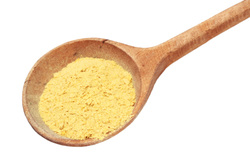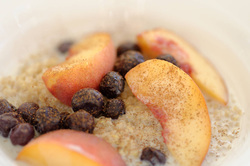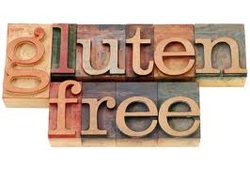 Jenelle Croatto APD After an influx of referrals last week for clients wanting advice on following a Candida Diet to prevent and/or treat thrush, I only thought it was appropriate to discuss the science surrounding this idea. The theory that by following a ‘yeast free’ diet will prevent excessive growth of candida was particularly popular during the 1980’s and was commonly recommended. However it gradually faded as a form of treatment in orthodox medical circles following a study which was released in 1990[1], and subsequent research into the area. One reason that the idea of a ‘yeast free’ diet gained traction is because some women with intolerances to natural food chemicals (most commonly, salicylates) will often experience vaginal irritation and mouth ulcers, sometimes with tongue coating. Based on clinical presentation only, many medical practitioners have come to the misdiagnoses of thrush. To properly diagnose thrush a swab needs to be conducted. If candida has been identified then it is treatable with an anti-fungal agent. However, if the result is negative then diet may be explored as a possible cause of symptoms. Another area of confusion surrounds that of allergy testing. Individuals who present with a positive skin prick test (SPT) to yeast/candida may be lead to think that they are allergic. In fact this is only indicative of exposure, which is universal, and not a clinical diagnosis of an allergy, or a valid reason to commence a ‘yeast free’ diet. At times the line between food and clinical symptoms can be quite blurred, and I can appreciate that it can be tricky to pin point what may be causing issues. For this reason, if anyone is suspecting that they may have some form of sensitivity to food I strongly encourage involvement with a medical practitioner and Dietitian who are experienced in the area of food sensitivities. Following a restrictive diet without the guidance of a Dietitian may lead to a diet that is nutritionally inadequate and inappropriate. [1] A RANDOMISED, DOUBLE-BLIND TRIAL OF NYSTATIN THERAPY FOR THE CANDIDIASIS HYPERSENTIVITY SYNDROME. N Engl J Med (1990); 323:1717-23
0 Comments
 I love quinoa and I love porridge... So it won't be a surprise that Quinoa Porridge is regular breakfast for me. I love it because it tastes great and has all the nutritional 'checks' I need. With my dietary requirements, it's a sure fire winner. Plus it keeps me satisfied for hours. Each seed of quinoa contains smart carbs and protein... So this little seed has a strong nutritional punch. It's a winner amongst those wanting a 'Paleo' style diet and those who require a gluten free diet. What you see above is my breakfast this morning. Warm, creamy porridge with some lovely fresh peach, blueberries and a sprinkling of cinnamon. You can top it with whatever you have on hand. Here are just a few ideas :
My husband thought it looked great... but being my resident 'Heston' he came up with his own version below. A smooth porridge using ground quinoa. He used the coffee grinder to make the quinoa 'fine' before cooking it. It looked a little like a thick yoghurt and we think it would make great baby food!  For those that don't like the texture of quinoa, the ground version might be worth a try! Before I pass on his tips let me explain how to make basic quinoa porridge on the stove top or in the microwave. You can tailor this recipe for your own dietary requirements or tastes using any type of milk... Skim, soy, coconut, almond, oat, rice or just water. So when I refer to 'milk' it can be any type of milk or even water. STOVE TOP: MAKES 3-4 SERVES Combine 1 cup of quinoa to 2 cups milk. Boil gently and let simmer for about 20-25 mins, stirring occasionally to check that it hasn't burned or boiled dry. You will know when it is cooked because it will be translucent and form little tails. Serve with your desired topping. MICROWAVE: MAKES 3-4 SERVES Combine 1 cup of quinoa to 2 cups milk. Cook on high for 2-3 mins. Stir and then cook on low for 15mins. You will know when it is cooked because it will be translucent and form little tails. Serve with your desired topping. All microwaves are different, so first time round, keep watch for that translucent look. SMOOTH QUINOA: Heston Husband Tips! :)
So, have a play! Quinoa is such a great little seed and we love it. It is a versatile cooking ingredient (just see my recipe page) and it's very nutritious. Share with me your favourite quinoa recipes and tips on Twitter @lise_simpson Live, love, life... Lisa xo  About ten years ago I was diagnosed with Coeliac Disease. At the time I wasn’t sure what that was, but I recall my gastroenterologist saying “No more breads and cereals for you”. A decade ago I hadn’t heard of Coeliac Disease and the term ‘gluten free’ wasn’t something I had ever come across. I remember thinking I would starve to death. Each morning I’d consume two Weet-Bix for breakfast and always had a salad sandwich from the school canteen for lunch. After going to the gym in the evenings I’d eat a bowl of untoasted muesli as I prepared a vegetarian dinner that usually featured pasta or couscous. Back in the day (before becoming a dietitian) I thought my diet was pretty ‘bang on’; but it was making me sick, it was full of gluten and I was always hungry. My Coeliac Disease meant that I wasn’t absorbing certain nutrients and my intestines were in a bad way. All that seems like a lifetime ago, but I remember feeling overwhelmed and unsure about what I should eat. There wasn’t a shopping aisle devoted to gluten free goodies back then. I started out devouring bucket loads of rice to fuel my training as a group fitness instructor. My rice cooker was used almost every night. Let me tell you, there are loads of nutrient dense gluten free carbohydrate sources other than rice! Ten years after my diagnosis there are now hundreds of gluten free products available and strangely eating ‘gluten free’ has become some sort of trend. People seem to think that eating gluten free will make them lose weight or that it’s healthier, but to be honest, some gluten free products are ghastly and are often high GI and laden with fat or sugar. Fact is, eating gluten free won’t help you lose weight and isn’t always the best option; that is unless you have gluten intolerance or Coeliac Disease. Dr. David Katz, director of the Yale University Prevention Research Center, said people who cut gluten to stay slim are relying on a strategy common to almost all quick-fix diets: restricting food choices. “When people have fewer choices, they tend to eat less and lose weight accordingly,” he said. “But you could accomplish the same thing by consuming only healthful, wholesome foods, including whole grains that do contain gluten. The result would be an easier, more sustainable, and potentially more nutritious diet overall.” There is nothing unhealthy about gluten unless someone has a true sensitivity or Coeliac Disease like myself. Gluten is simply a protein that has been in the human diet since the dawn of agriculture and acts like a ‘glue’ in baked goods; giving stretch and rise to foods like breads. If you suspect you have a gluten intolerance or Coeliac Disease you need to be tested. If the results come back positive, I promise you, you won’t starve to death and you will feel so much better. It’s important you seek advice from an Accredited Practising Dietitian like Dr Joanna or myself to help you establish a well balanced gluten free diet. If your results come back negative, don’t cut out wholegrain breads and cereals because you think you’ll be healthier. Wholegrains are a superb source of fibre and minerals that will keep your gut and bowel healthy for life. For more information about symptoms and testing, I highly recommend checking out this website:http://www.coeliac.org.au/ . Here you will learn about symptoms, diagnosis and following a gluten free diet if you are diagnosed with an intolerance or Coeliac Disease like me. Live, love, life… Lisa x |
News FEEDFitness, Energy, Education & Diet Archives
June 2020
Categories
All
|
 RSS Feed
RSS Feed